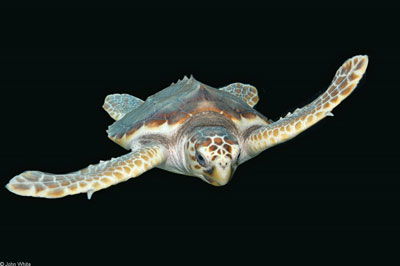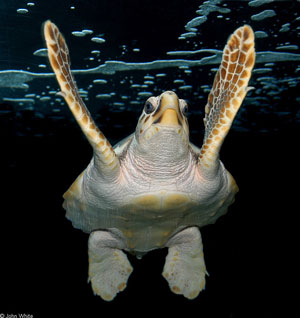Field Guide to Maryland's Turtles (Order Testudines)
Main_Content
Loggerhead Sea Turtle (Caretta caretta) | | Common Name:
|

Photo of Loggerhead Seaturtle courtesy of JohnWhite
|
Size: 31 - 45 inches. Record – 83 inches |
Appearance:

Photo of Loggerhead Sea Turtle
(ventral view) courtesy of John White
- This is the largest living hard-shelled turtle (Leatherbacks are
larger, but soft-shelled).
- Five or more costal scutes on each side of the heart-shaped
carapace, or top shell.
- The first costal scute touches the nuchal scute.
- The elongated carapace is reddish brown often tinged with olive, and
scutes may also have a yellow border.
- The large scutes on the large head follow this color pattern also.
- The rear border of the carapace is serrated in all but the largest
specimens.
- Carapace often encrusted with barnacles.
- The plastron (bottom shell) is cream to yellow.
- Upper surface of neck and flippers are reddish brown, while
undersurfaces are cream to yellow.
- Three enlarged bridge scutes, which do not have pores.
|
Habitats:Open sea to near shore and brackish bays. Occasionally found in the tidal
brackish portions of larger coastal rivers. Nest on sandy ocean-side
beaches.
|
How to Find:Our most common sea turtle, they can be viewed from May to November near
shore and offshore (adults) or in the Chesapeake and Coastal Bays
(juveniles) while boating, as they spend a great deal of time floating on
the surface. In recent years there have been a few nesting attempts on the
beaches of Fenwick and Assateague Islands. Nesting is typically at night
from June to August.
|
Distribution in Maryland:Aquatic areas of the Coastal Bays and Chesapeake. May nest in Worcester County. This turtle is listed as Federally and State Threatened. If found, please report sightings to the Maryland Wildlife and Heritage Service. If found stranded or dead, please report sightings. |
|
